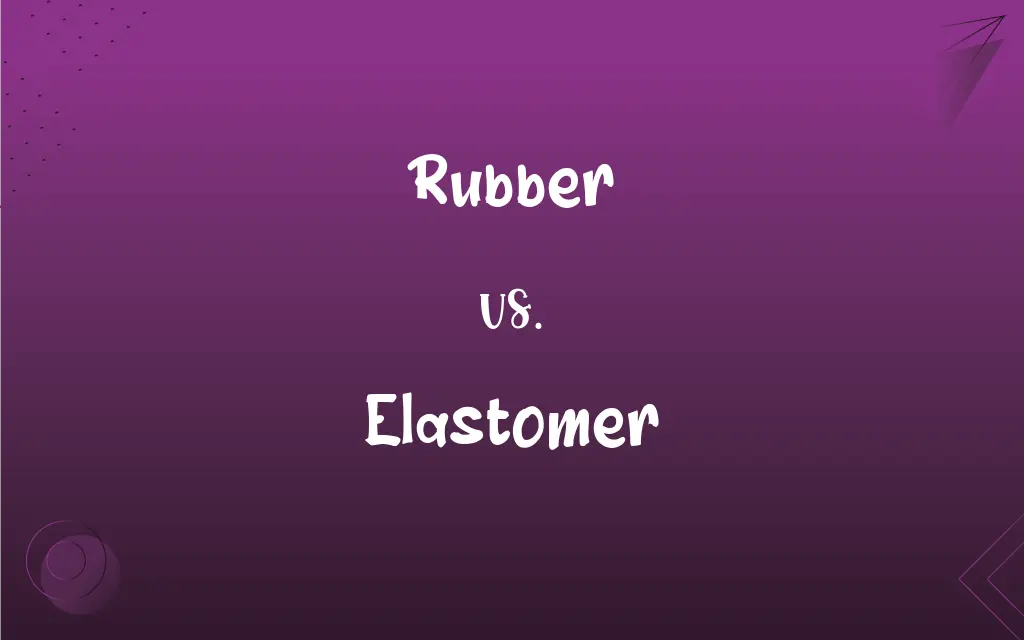Rubber vs. Elastomer: What's the Difference?
Edited by Aimie Carlson || By Harlon Moss || Updated on November 2, 2023
Rubber is a natural polymer, whereas elastomer is a broader term for materials with rubber-like elasticity.

Key Differences
Rubber is a specific natural material known for its elasticity and waterproof qualities. Derived from the latex of rubber trees, it has been essential in many industries for its natural stretchable properties. Elastomers are a category of polymers that include rubber and synthetic materials with similar elastic properties. All rubbers are elastomers, but not all elastomers are rubber.
Rubber is frequently used in its natural form but can also be synthetically produced, emulating the properties of natural rubber. The term 'elastomer' encompasses all these materials, highlighting the property of significant elasticity after deformation. It is the technical term used in polymer science, indicating a broader spectrum of materials than just natural or synthetic rubber.
In practical applications, rubber often refers to materials used in tires, footwear, and gaskets. Elastomers are considered in a wider context, including silicone, neoprene, and other rubber-like synthetics that serve in a wider range of applications, such as in biomedical devices or as sealants in a variety of industries.
Rubber has a rich history, particularly associated with the rise of the automobile industry where it has been used in tires. Elastomers have been developed more recently, with advancements in polymer chemistry that allow for a vast range of properties and uses beyond what natural rubber could offer.
While rubber is sometimes colloquially used to describe various flexible materials, from an engineering standpoint, the distinction is important. Elastomers represent a broad class of materials with the common characteristic of high elasticity, while rubber is a subset within this class, either natural or synthetic with specific chemical compositions.
ADVERTISEMENT
Comparison Chart
Source
Primarily natural, from latex; can be synthetic.
Includes all materials with rubber-like properties.
Composition
Isoprene as primary constituent.
Wide range, including silicones, polyurethanes, etc.
Terminology Usage
Often refers to natural product.
Technical term used in material sciences.
Variety
Limited to natural and some synthetic types.
Encompasses a broad range of synthetic materials.
Elasticity
Naturally elastic.
Defined by the property of elasticity, not composition.
ADVERTISEMENT
Rubber and Elastomer Definitions
Rubber
A flexible, elastic material made from the latex of a rubber tree.
Tires are commonly made from rubber.
Elastomer
Any polymer that exhibits extreme elasticity.
Silicone is a type of elastomer used in kitchen utensils.
Rubber
An object made of rubber for removing pencil marks.
She used a rubber to erase the mistake in her drawing.
Elastomer
Used in materials to reduce vibration.
Elastomer mounts are used to dampen vibrations in machinery.
Rubber
Garments made from a rubberized fabric to prevent water penetration.
Fishermen wear rubber overalls to stay dry.
Elastomer
Materials used in the construction of flexible medical tools.
The catheter is made with a medical-grade elastomer.
Rubber
Used as an electrical insulator due to its non-conductive properties.
Rubber gloves are essential for electrical work.
Elastomer
An elastomer known for maintaining properties under high temperatures.
The gaskets are made of a heat-resistant elastomer.
Rubber
A colloquial term for a contraceptive device.
He bought a rubber from the pharmacy.
Elastomer
A substance used to seal joints or gaps.
The window seals were made from a durable elastomer.
Rubber
A yellowish, amorphous, elastic material, composed almost entirely of an isoprene polymer, obtained from the milky sap or latex of various tropical plants, especially the rubber tree, and vulcanized, pigmented, finished, and modified into products such as electric insulation, elastic bands and belts, tires, and containers. Also called caoutchouc, India rubber.
Elastomer
Any of various polymers having the elastic properties of natural rubber.
Rubber
Any of numerous synthetic elastic materials of varying chemical composition with properties similar to those of natural rubber; an elastomer.
Elastomer
Any polymer having the elastic properties of rubber
Elastomer
Any of various elastic materials that resemble rubber (resumes its original shape when a deforming force is removed)
FAQs
Is silicone a rubber or an elastomer?
Silicone is a synthetic elastomer, not classified as natural rubber.
Are all rubbers considered elastomers?
Yes, all rubbers are a type of elastomer.
Can elastomers be natural?
While elastomers are often synthetic, natural rubber is also an elastomer.
What is the primary use of rubber?
Rubber is primarily used in tires, seals, and as an insulating material.
Are there biodegradable elastomers?
Yes, there are biodegradable elastomers, which are a focus of recent research.
Can rubber be recycled?
Rubber can be recycled, though the process can be complex.
Are elastomers always flexible?
Yes, the defining characteristic of elastomers is their flexibility and elasticity.
What's the main component of natural rubber?
The main component of natural rubber is polyisoprene.
Are elastomers used in aerospace?
Yes, elastomers are used in aerospace for seals and gaskets due to their resilience.
Can rubber be made synthetically?
Yes, synthetic rubbers are made from petroleum byproducts.
Do elastomers contain plasticizers?
Some elastomers may contain plasticizers to modify their properties.
What makes elastomers different from plastics?
Elastomers have higher elasticity compared to most plastics, which are usually more rigid.
Is vulcanized rubber still an elastomer?
Yes, vulcanized rubber is an elastomer that has been chemically treated to improve durability.
How is rubber harvested?
Rubber is harvested by tapping into the bark of rubber trees to collect the latex.
Is rubber biodegradable?
Natural rubber is biodegradable, but synthetic rubber may not be.
What are thermoplastic elastomers (TPEs)?
TPEs are a class of elastomers that can be repeatedly melted and reshaped.
Can elastomers conduct electricity?
Most elastomers, including rubber, are electrical insulators.
Do all elastomers have the same properties?
No, elastomers can vary widely in properties like temperature resistance and hardness.
What industries use rubber extensively?
The automotive, manufacturing, and footwear industries use rubber extensively.
Is latex the same as rubber?
Latex is the natural sap of rubber trees, which is processed to make natural rubber.
About Author
Written by
Harlon MossHarlon is a seasoned quality moderator and accomplished content writer for Difference Wiki. An alumnus of the prestigious University of California, he earned his degree in Computer Science. Leveraging his academic background, Harlon brings a meticulous and informed perspective to his work, ensuring content accuracy and excellence.
Edited by
Aimie CarlsonAimie Carlson, holding a master's degree in English literature, is a fervent English language enthusiast. She lends her writing talents to Difference Wiki, a prominent website that specializes in comparisons, offering readers insightful analyses that both captivate and inform.































































